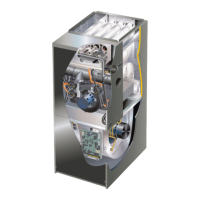Switches 14 through 19 -- Heating Mode Blower Speed
-- Switches 14 through 19 are used to select heating mode
blower motor speeds. These switches are factory set at the
OFF position which provides 100 % of normal speed during
HIGH HEAT demand, 70% of normal speed during MID-
RANGE HEAT demand and 40% of normal speed during
LOW HEAT demand. Switches 14, 15 and 16 are used to
adjust the LOW HEAT blower motor speed, Switches 17,
18 and 19 are used to adjust the HIGH HEAT blower motor
speed, Table 17 provides the heating mode blower speeds
that will result from different switch settings. Refer to tables
21 through 31 for corresponding cfm values,
TABLE 17
Low Heat Blower Speeds
Thermostat
Demand
Low Heat
(Rto Wl)
Blower
Speed
Adjust-
ments
+15%
+7.5%
Normal
-7.5%
-15%
DIP SWITCH SETTINGS
14 15 16
On Off On
On Off Off
Off Off Off
On On Off
On On On
Thermostat
Demand
High Heat
(R to
w1 & w2)
TABLE 18
High Heat Blower Speeds
Blower DIP SWITCH
Speed
Adjust-
ments
+15%
+7.5%
Normal
-7.5%
-15%
SETTINGS
17 18 19
On Off On
On Off Off
Off Off Off
On On Off
On On On
On-Board Link W914 -- Figure 42
On-board link W914, is a clippable connection between ter-
minals DS and R on the integrated control. W914 must be
cut when the furnace is installed with either the Harmony
111'" zone control or a thermostat which features humidity
control. If the link is left intact the PMW signal from the Har-
mony Iti control will be blocked and also lead to control
damage. Refer to table 19 for operation sequence in ap-
plications including G71MPP, a thermostat which features
humidity control and a single-speed outdoor unit. Table 20
gives the operation sequence in applications with a two-
speed outdoor unit,
On-Board Link W951 -- Figure 42
On-board link W951 is a clippable connection between ter-
minals R and O on the integrated control. W951 must be cut
when the furnace is installed in applications which include a
heat pump unit and a thermostat which features dual fuel
use, If the link is left intact, terminal "O" will remain ener-
gized eliminating the HEAT MODE in the heat pump,
On-Board Link W915 -- Figure 42
On-board link W915 is a clippable connection between ter-
minals Y1 and Y2 on the integrated control. W915 must be
cut if two-stage cooling will be used. If the link is not cut the
outdoor unit will operate in second-stage cooling only,
Diagnostic LED -- Figure 42
The seven-segment diagnostic LED displays operating
status, target airflow, error codes and other information,
The table on page 58 lists diagnostic LED codes,
Diagnostic Push Button -- Figure 42
The diagnostic push button is located adjacent to the
seven-segment diagnostic LED. This button is used to en-
able the Error Code Recall mode and the Field Test mode.
Press the button and hold it to cycle through a menu of op-
tions, Every five seconds a new menu item will be dis-
played. When the button is released, the displayed item will
be selected. Once all items in the menu have been dis-
played, the menu resumes from the beginning until the but-
ton is released,
Error Code Recall Mode
Select "E" from the menu to access the most recent 10 error
codes. Select "c" from the Error Code Recall menu to clear
all error codes, Button must be pressed a second time
while "c" is flashing to confirm command to delete codes.
Press the button until a solid "---"is displayed to exit the Error
Code Recall mode,
Field Test Mode
Use the diagnostic push button to scroll through the menu
as described above. Release the button when the LED
flashes "-" to select the Field Test mode.
While in the Field Test mode the technician can:
• Initiate furnace ignition and move to and hold low-fire
rate by applying a R to W1 jumper.
• Initiate furnace ignition sequence and move to and
hold high-fire rate by applying a jumper from R to W1
and W2.
• Initiate furnace ignition sequence and move to and
hold mid-fire rate by applying a jumper to R and W2.
• Apply then remove the jumper from R to W1 and W2 to
change the firing rate from low fire to mid fire and high
fire.
• A vent calibration sequence can be initiated even if a
thermostat signal is not present. Press and hold the
push button until a solid "C" is displayed. Release the
button and calibration will begin. The furnace will per-
form the high-fire and low-fire pressure switch calibra-
tions and display "CAL". After calibration, the LED will
return to the flashing "-" display.
During Field Test mode operation, all safety switches are
still in the circuit (they are not by-passed) and indoor blower
performance and timings will match DIP switch selections.
Current furnace firing rate, indoor blower CFM and flame
signal will be displayed. To exit the Field Test mode, press
and hold the button. The menu will resume from the begin-
ning. Also, cycle the main power to exit the Field Test
mode. The integrated control will automatically exit the
Field Test mode after 45 minutes of operation.
Page 36

